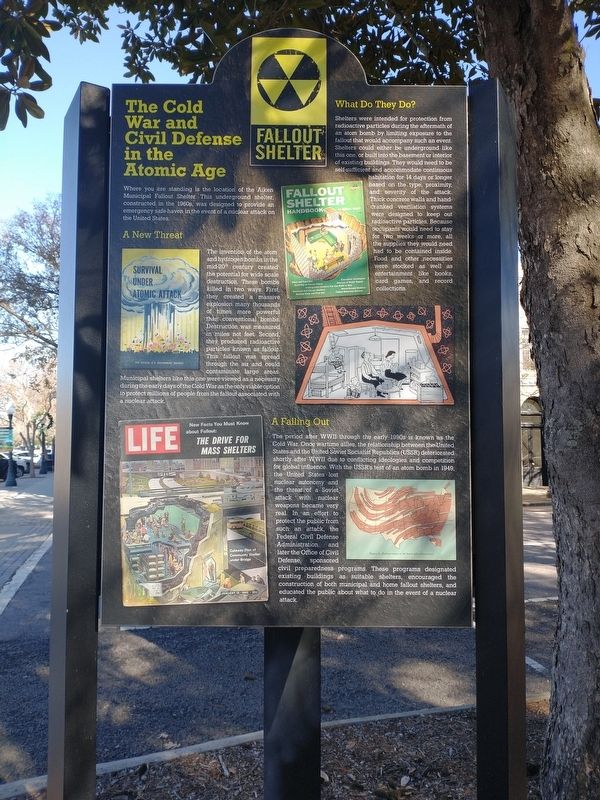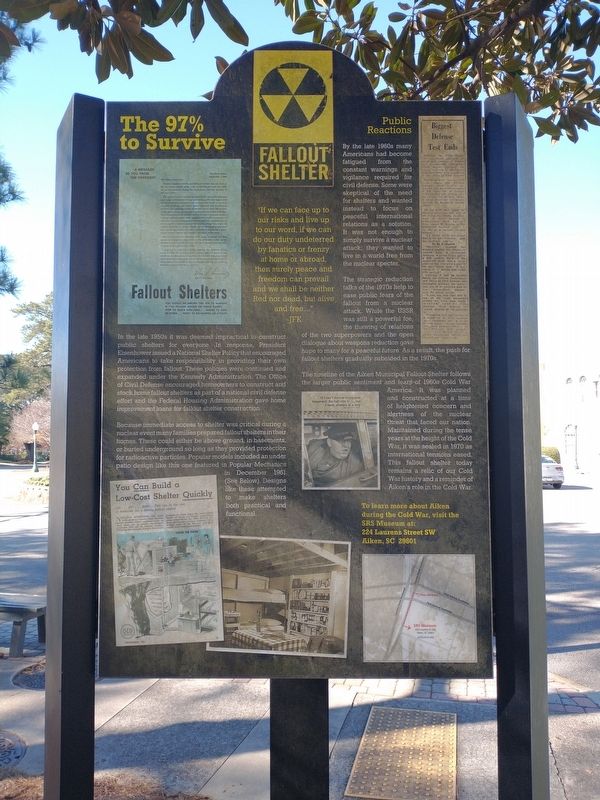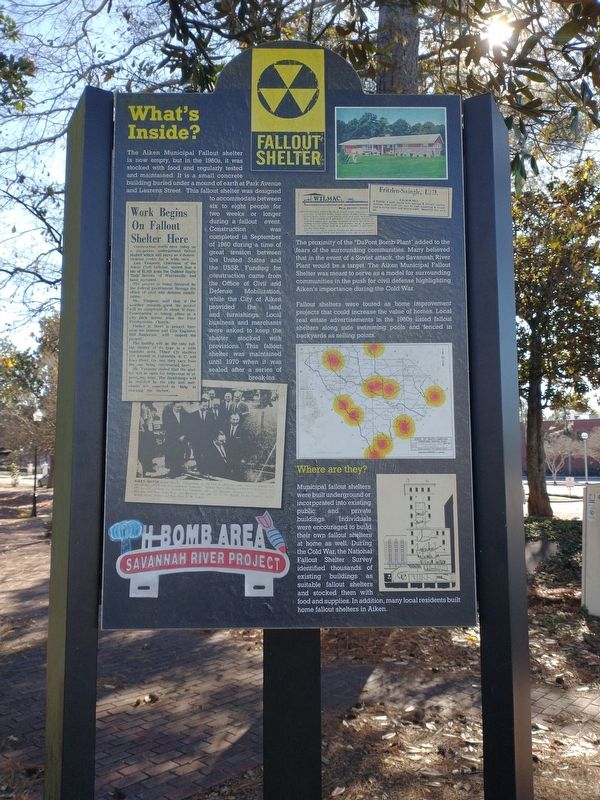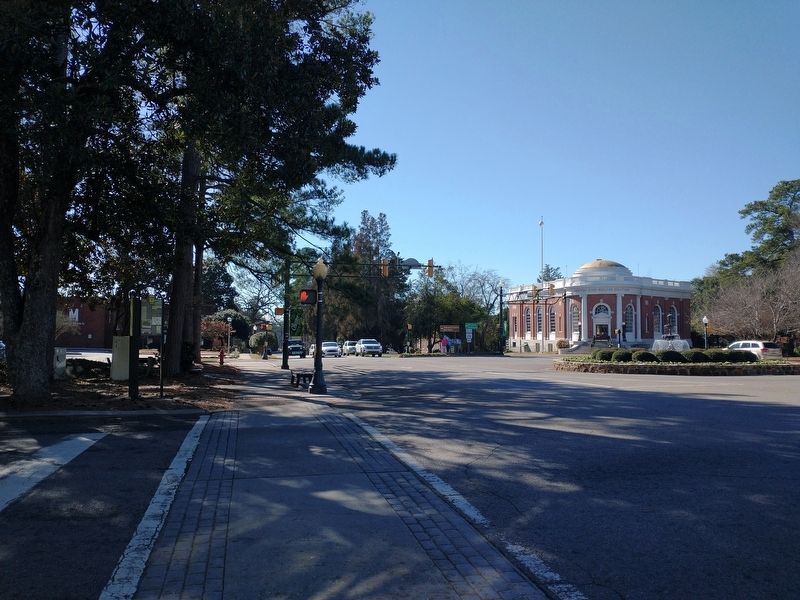Aiken in Aiken County, South Carolina — The American South (South Atlantic)
Fallout Shelter
(panel 1)
The Cold War and Civil Defense in the Atomic Age
Where you are standing is the location of the Aiken Municipal Fallout Shelter. This underground shelter, constructed in the 1960s, was designed to provide an emergency save-haven in the event of a nuclear attack on the United States.
A New Threat
The invention of the atom and hydrogen bombs in the mid-20th century created the potential for wide scale destruction. These bombs killed in two ways. First, they created a massive explosion many thousands of times more powerful than conventional bombs. Destruction was measured in miles not feet. Second, they produced radioactive particles known as fallout. This fallout was spread through the air and could contaminate large areas. Municipal shelters like this one were viewed as a necessity during the early days of the Cold War as the only viable option to protect millions of people from the fallout associated with a nuclear attack.
What Do They Do?
Shelters were intended for protection from radioactive particles during the aftermath of an atom bomb by limiting exposure to the fallout that would accompany such an event. Shelters could either be underground like this one, or built into the basement of interior of existing buildings. They would need to be self-sufficient and accommodate continuous habitation for 14 days or longer base on the type, proximity, and severity of the attack. Thick concrete walls and hand-cracked ventilation systems were designed to keep out radioactive particles. Because occupants would need to stay for two weeks or more, all the supplies they would need had to be contained inside. Food and other necessities were stocked as well as entertainment like books, card games, and record collections.
A Falling Out
The period after WWII through the early 1990s is known as the Cold War. Once wartime allies, the relationship between the United States and the United Soviet Socialist Republics (USSR) deteriorated shortly after WWII due to conflicting ideologies and competition for global influence. With the USSR’s test of an atom bomb in 1949, the United States lose nuclear autonomy and the threat of a Soviet attack became very real. In an effort to protect the public from such an attack, the Federal Civil Defense Administration and later the Office of Civil Defense, sponsored civil preparedness programs. These programs designated existing buildings as suitable shelters, and educated the public about what to do in the event of a nuclear attack.
(panel 2)
The 97% to Survive
In the late 1950s it was deemed impractical to construct public shelters for everyone. In response, President Eisenhower issued a National Shelter Policy that encouraged Americans to take responsibility in providing their own protection from fallout. These policies were continued and expanded under the Kennedy Administration. The Office of Civil Defense encouraged homeowners to construct and stock home fallout shelters as part of a national civil defense effort and the Federal Housing Administration gave home improvement loans for fallout shelter construction.
Because immediate access to shelter was critical during a nuclear event many families prepared fallout shelters in their homes. These could either be above ground, in basements, or buries underground so long as they provided protection for radioactive particles. Popular models included an under patio design like this one featured in Popular Mechanics in December 1961 (See Below). Designs like these attempted to make shelters both practical and functional.
(insert) “If we can face up to our risks and live up to our word, if we can do our duty undeterred by fanatics or frenzy at home or abroad, then surely peace and freedom can prevail and we shall be neither Red nor dead, but alive and free…” – JFK
Public Reactions
By the late 1960s many Americans had become fatigued from the constant warnings and vigilance required for civil defense. Some were skeptical of the need for shelters and wanted instead to focus on peaceful international relations as a solution. It was not enough to simply survive a nuclear attack; they wanted to live in a world free from the nuclear specter.
The strategic reduction talks of the 1970s help to ease public fears of the fallout from a nuclear attack. While the USSR was still a powerful foe, the thawing of relations of the two superpowers and the open dialogue about weapons reduction gave hope to many for a peaceful future. As a result, the push for fallout shelters gradually subsided in the 1970s.
The timeline of the Aiken Municipal Fallout Shelter follows the larger public sentiment and fears of 1960s Cold War America. It was planned and constructed at a time of heightened concern and alertness of the nuclear threat that faced our nation. Maintained during the tense years at the height of the Cold War, it was sealed in 1970 as international tensions eased. This fallout shelter today remains a relic of our Cold War history and a reminder of Aiken’s role in the Cold War.
(insert) To learn more about Aiken during the Cold War, visit the SRS Museum at: 224 Laurens Street SW Aiken, SC 29801
(panel 3)
What's Inside?
The Aiken Municipal Fallout Shelter is now empty, but in the late 1960s, it was stocked with food and regularly tested and maintained. It is a small concrete building buried under a mound of earth at Park Avenue and Laurens Street. This fallout out shelter was designed to accommodate between six to eight people for two weeks or longer during a fallout event. Construction was completed in September of 1960 during a time of great tension between the United States and the USSR. Funding for the construction came from the Office of Civil and Defense Mobilization, while the City of Aiken provided the land and furnishings. Local business and merchants were asked to keep the shelter stocked with provisions. This fallout shelter was maintained until 1970 when it was sealed after a series of break-ins.
The proximity of the “Dupont Bomb Plant” added to the fears of the surrounding communities. Many believed that in the event of a Soviet attack, the Savannah River Plant would be a target. The Aiken Municipal Fallout Shelter was meant to serve as a model for surrounding communities in the push for civil defense highlighting Aiken’s importance during the Cold War.
Fallout Shelters were touted as home improvement projects that could increase the value of homes. Local real estate advertisements in the 1960s listed fallout shelters along side swimming pools and fenced in backyards as selling points.
Where are they?
Municipal fallout shelters were built underground of incorporated into existing public and private buildings. Individuals were encouraged to build their own fallout shelters at home as well. During the Cold War, the National Fallout Shelter Survey identified thousands of existing buildings as suitable fallout shelters and stocked them with food and supplies. In addition, many local residents built home fallout shelters in Aiken.
Topics. This historical marker is listed in this topic list: War, Cold. A significant historical month for this entry is September 1960.
Location. 33° 33.579′ N, 81° 43.388′ W. Marker is in Aiken, South Carolina, in Aiken County. Marker is at the intersection of Laurens Street SW and Park Avenue SW, on the right when traveling north on Laurens Street SW. Touch for map. Marker is in this post office area: Aiken SC 29801, United States of America. Touch for directions.
Other nearby markers. At least 8 other markers are within walking distance of this marker. South Carolina Canal & Rail Road Company (within shouting distance of this marker); Fred B. Cavanaugh (within shouting distance of this marker); The S.C. Railroad (within shouting distance of this marker); Woodmen Of The World (within shouting distance of this marker); Aiken (about 300 feet away, measured in a direct line); Plutonium-238 for Space Exploration (about 400 feet away); Dibble Memorial Library (about 400 feet away); Aiken's Jewish Merchants (about 500 feet away). Touch for a list and map of all markers in Aiken.
Also see . . . Savannah River Site Museum (SRS). he Savannah River Site Museum is dedicated to bringing the stories of Savannah River Site, its scientific and technological role in the Cold War, to life. (Submitted on January 12, 2024.)
Credits. This page was last revised on January 12, 2024. It was originally submitted on January 11, 2024, by Tom Bosse of Jefferson City, Tennessee. This page has been viewed 155 times since then. Photos: 1, 2, 3, 4. submitted on January 11, 2024, by Tom Bosse of Jefferson City, Tennessee. • Bernard Fisher was the editor who published this page.



